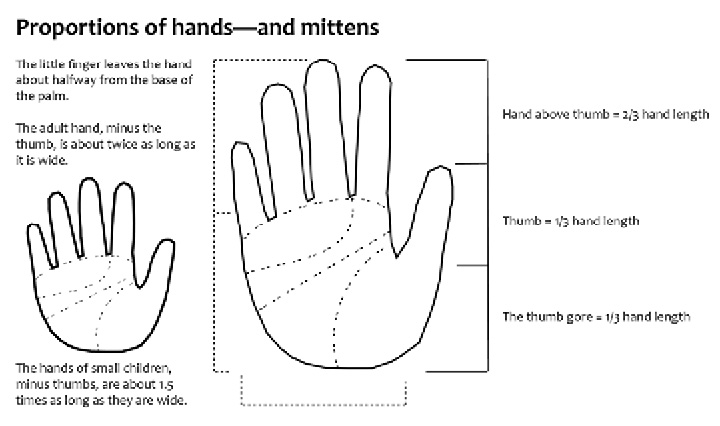A Mitten Is Shaped Like a Hand
A mitten is shaped like a hand, but hands are different in Uzbekistan and Norway, Nepal and Massachusetts. Some hands are square, with little difference in finger lengths, others are narrow, with a long middle finger poking up in the middle.
Because of this, a mitten from Nepal might not fit a Scot in New Hampshire. But when making mittens for yourself or someone in your family, you can measure hands. With measurements in hand, you can develop a mitten or glove pattern that will fit that hand, be it short and fat, long and narrow, tiny or large.
You can do this because, like the rest of the body, hands have proportions that are fairly constant. These can be used to make a mitten out of anything from yarn to Gore-tex or yak wool for anyone from Nepal to Texas. If you like to rely on paper patterns, you can make a life-size one based on your measurements. This can also be used to check your measurements as you knit.
Widthwise, the measurement you need is around the hand at the knuckles. Wrap the tape measure loosely, so that you can move it but it still touches on three sides, or wrap it tightly around your knuckles including the tip of the thumb. Call this number “100 percent,” à la Elizabeth Zimmermann’s Percentage System of knitting pattern development. (Thank you, Elizabeth!) Two other measurements—the cuff, which can be as loose as 100 percent but is usually 80 to 85 percent, and the thumb—are based on this 100-percent figure.
The thumb is almost always a startling 41 percent. As part of the thumb’s width is at the base of the mitten before the increases, and part will be picked up above the thumb hole, you need to add about 20 percent more stitches between the cuff and taking off the thumb gore—both to bring the measurement around the hand to 100 percent and to allow for the width of the hand at the thumb joint. This 20 percent is put on a holder at the thumb joint and usually only partially replaced by casting on additional stitches above the thumb hole.
A rule of thumb: Lengthwise, measure the hand from the tip of the middle finger to the base of the palm—that is, to the crease where fingerprint skin ends. (I add a solid half-inch to that to allow for the thickness of the hand.)
The hand is neatly divided into thirds of this length: the thumb gore and the thumb are each one-third, and the hand above the thumb gore is two-thirds of this figure. Check this on your own hand.

If the live thumb were easy to measure, we could call the lengthwise proportions “The Rule of Thumb,” since everything is in proportion to the length of the thumb, but— too bad! It’s much easier to measure the hand than the thumb.
The cuff, ill-defined in length and shape, can conveniently be one-third the length of the hand, although some favor next to no cuff while others like cuffs to the elbows. Unless stated otherwise, all patterns in this book assume the cuff is one-third of the hand length.
Nora Johnson’s mother’s rule for adult mitten length was measured in bands of the six-round Fox & Geese pattern: “Three for the cuff, three for the thumb gore, three for the thumb, and five for the hand,” but I don’t think she counted the last little scrunched-up pattern where the final decreases took place.
If you hold by the thumb a mitten with a cuff one-third the length of the hand, the thumb is exactly in the middle lengthwise.
For gloves, the first finger to be separated after the thumb is the little finger, which leaves the hand halfway up. The other fingers are taken off in a group two or three rounds later.
